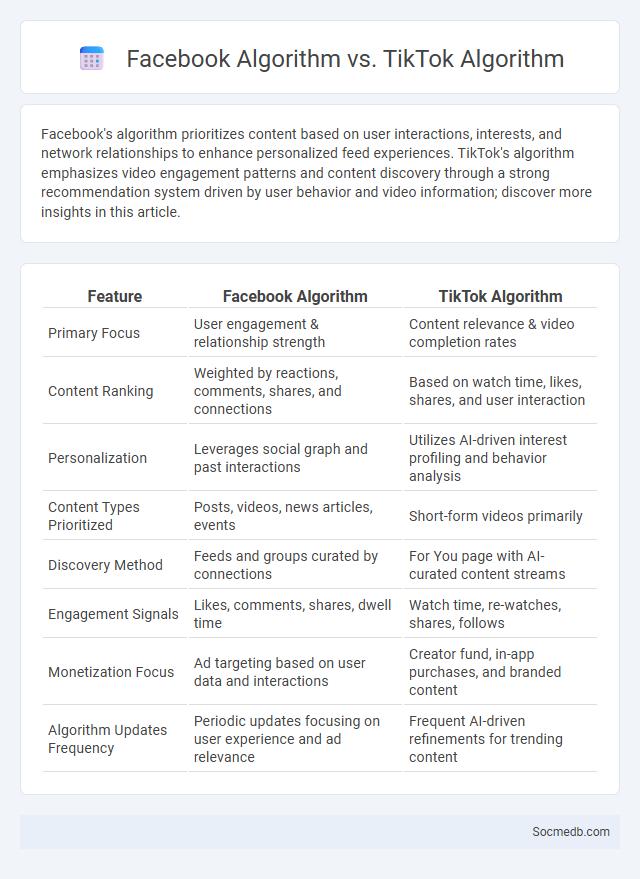
Photo illustration: Facebook Algorithm vs TikTok Algorithm
Facebook's algorithm prioritizes content based on user interactions, interests, and network relationships to enhance personalized feed experiences. TikTok's algorithm emphasizes video engagement patterns and content discovery through a strong recommendation system driven by user behavior and video information; discover more insights in this article.
Table of Comparison
| Feature | Facebook Algorithm | TikTok Algorithm |
|---|---|---|
| Primary Focus | User engagement & relationship strength | Content relevance & video completion rates |
| Content Ranking | Weighted by reactions, comments, shares, and connections | Based on watch time, likes, shares, and user interaction |
| Personalization | Leverages social graph and past interactions | Utilizes AI-driven interest profiling and behavior analysis |
| Content Types Prioritized | Posts, videos, news articles, events | Short-form videos primarily |
| Discovery Method | Feeds and groups curated by connections | For You page with AI-curated content streams |
| Engagement Signals | Likes, comments, shares, dwell time | Watch time, re-watches, shares, follows |
| Monetization Focus | Ad targeting based on user data and interactions | Creator fund, in-app purchases, and branded content |
| Algorithm Updates Frequency | Periodic updates focusing on user experience and ad relevance | Frequent AI-driven refinements for trending content |
Introduction to Social Media Algorithms
Social media algorithms determine the content you see by analyzing your interactions, preferences, and behavior to deliver personalized experiences. These complex systems prioritize posts, ads, and recommendations based on relevance, engagement, and timeliness. Understanding how these algorithms work can help your content reach the right audience and improve your online presence effectively.
Understanding Facebook’s Algorithm
Facebook's algorithm prioritizes content based on user engagement, relevance, and timeliness, ensuring your feed displays posts likely to interest you. Key factors include interactions with friends, groups, and Pages, as well as the type of content, such as videos, photos, or links. Understanding these elements helps you optimize your content strategy to increase visibility and reach on the platform.
Inside TikTok’s Content Recommendation System
TikTok's content recommendation system leverages an advanced algorithm that analyzes your interactions, watch time, and engagement patterns to deliver highly personalized video feeds. The system utilizes machine learning models to predict your preferences, continuously refining suggestions to keep you engaged and enhance user experience. By prioritizing content relevance and user behavior data, TikTok ensures your For You Page remains dynamic and tailored specifically to your interests.
The Basics of General Algorithms
Social media platforms rely on general algorithms to personalize user experiences by analyzing interaction patterns, content preferences, and engagement metrics. These algorithms prioritize delivering relevant posts, advertisements, and recommendations by using machine learning techniques that weigh factors like user behavior, trending topics, and network connections. Understanding the basics of these algorithms reveals how platforms optimize content visibility and user retention by constantly adapting to real-time data inputs.
How Facebook Algorithm Prioritizes Content
Facebook's algorithm prioritizes content by analyzing user engagement signals such as likes, comments, shares, and viewing duration to tailor your news feed. It ranks posts from friends, pages, and groups based on relevance, recent interactions, and content type preferences. Understanding this dynamic helps you optimize your posts to reach a targeted audience effectively.
TikTok’s For You Page: How the Algorithm Works
TikTok's For You Page (FYP) relies on a sophisticated algorithm that analyzes user interactions, video information, and device settings to personalize content feeds. The algorithm evaluates factors such as video likes, shares, comments, watch time, and user preferences to curate highly relevant short-form videos. Machine learning models continuously refine content recommendations, ensuring dynamic and engaging user experiences on TikTok's platform.
Key Differences Between Facebook and TikTok Algorithms
Facebook's algorithm prioritizes meaningful interactions, such as comments and shares, to connect you with content from friends, family, and groups, boosting posts that spark conversation. TikTok's algorithm centers around user engagement signals like video watch time, likes, and shares, created to showcase trendy and personalized short videos on your For You page. Understanding these fundamental differences can help you tailor your content strategy effectively for each platform's unique audience and features.
Impact on User Engagement and Reach
Social media platforms enhance user engagement by offering interactive features such as likes, comments, shares, and live streaming, which foster real-time communication and community building. Algorithms tailored to user preferences increase content visibility, thereby expanding reach and attracting diverse audiences. Effective use of targeted advertising and influencer partnerships further amplifies brand exposure and drives higher user interaction rates.
Algorithm Transparency and User Trust
Algorithm transparency is crucial for building user trust on social media platforms, as it allows users to understand how content is curated and prioritized in their feeds. Clear disclosures about data usage and recommendation systems empower users to make informed decisions, reducing misinformation and bias. Platforms that invest in transparency tend to see higher user engagement and loyalty, fostering a safer and more accountable digital environment.
Future Trends in Social Media Algorithms
Future trends in social media algorithms emphasize enhanced personalization through artificial intelligence and machine learning, enabling platforms to curate content more precisely based on user behavior and preferences. Increased integration of augmented reality (AR) and virtual reality (VR) will drive immersive experiences, while algorithms will prioritize authentic user engagement to combat misinformation and promote meaningful interactions. Predictive analytics will become crucial for anticipating trends and optimizing content delivery in real-time across platforms.
 socmedb.com
socmedb.com